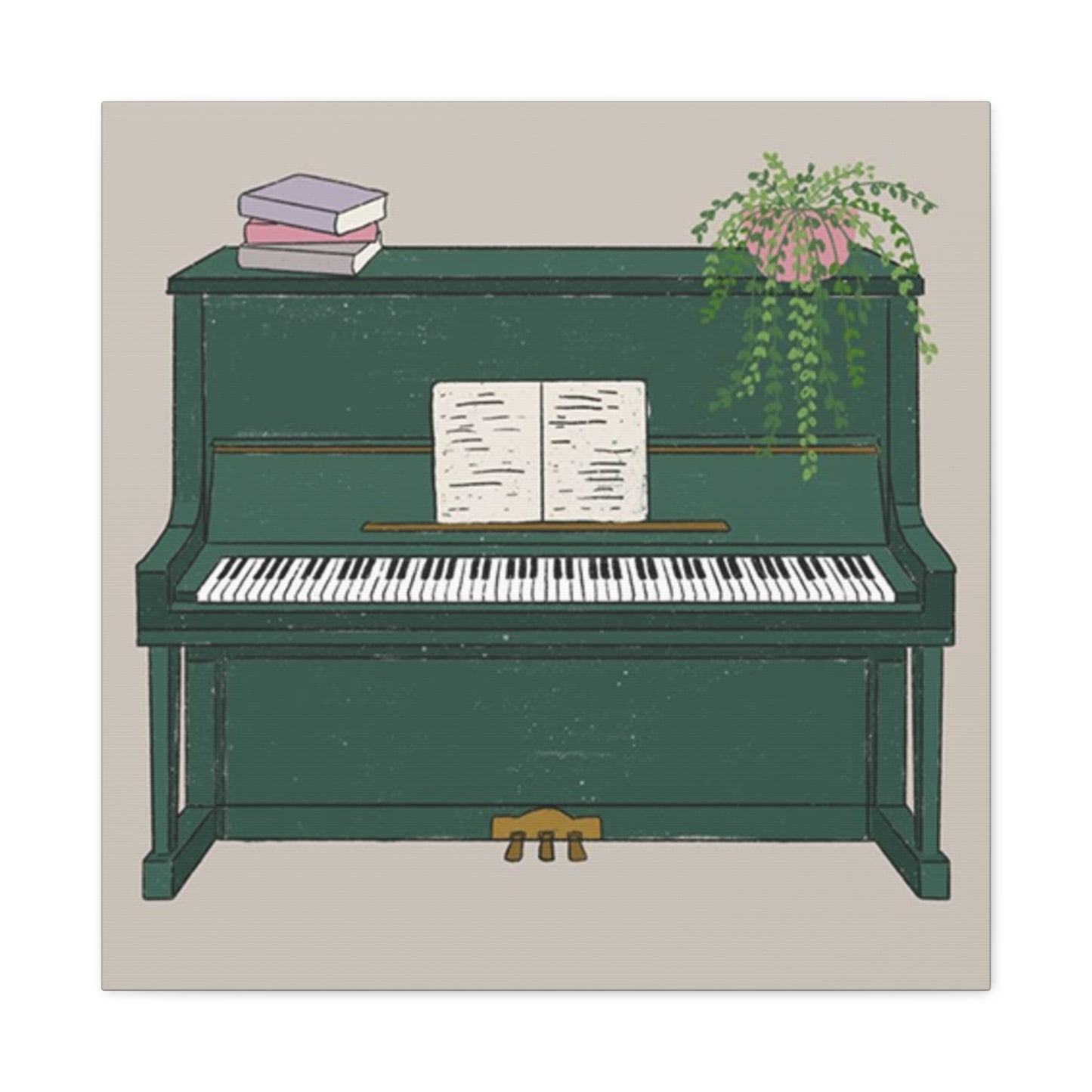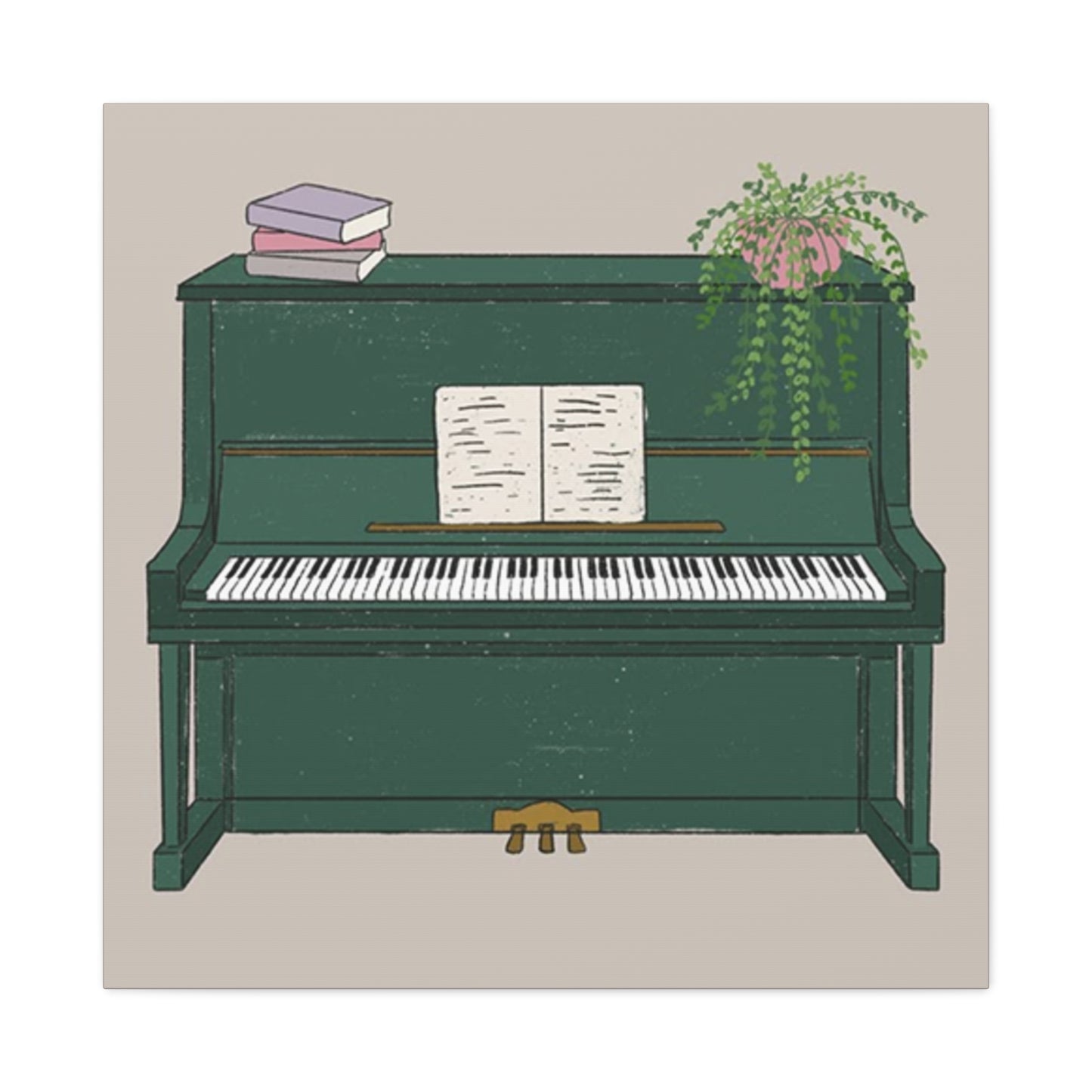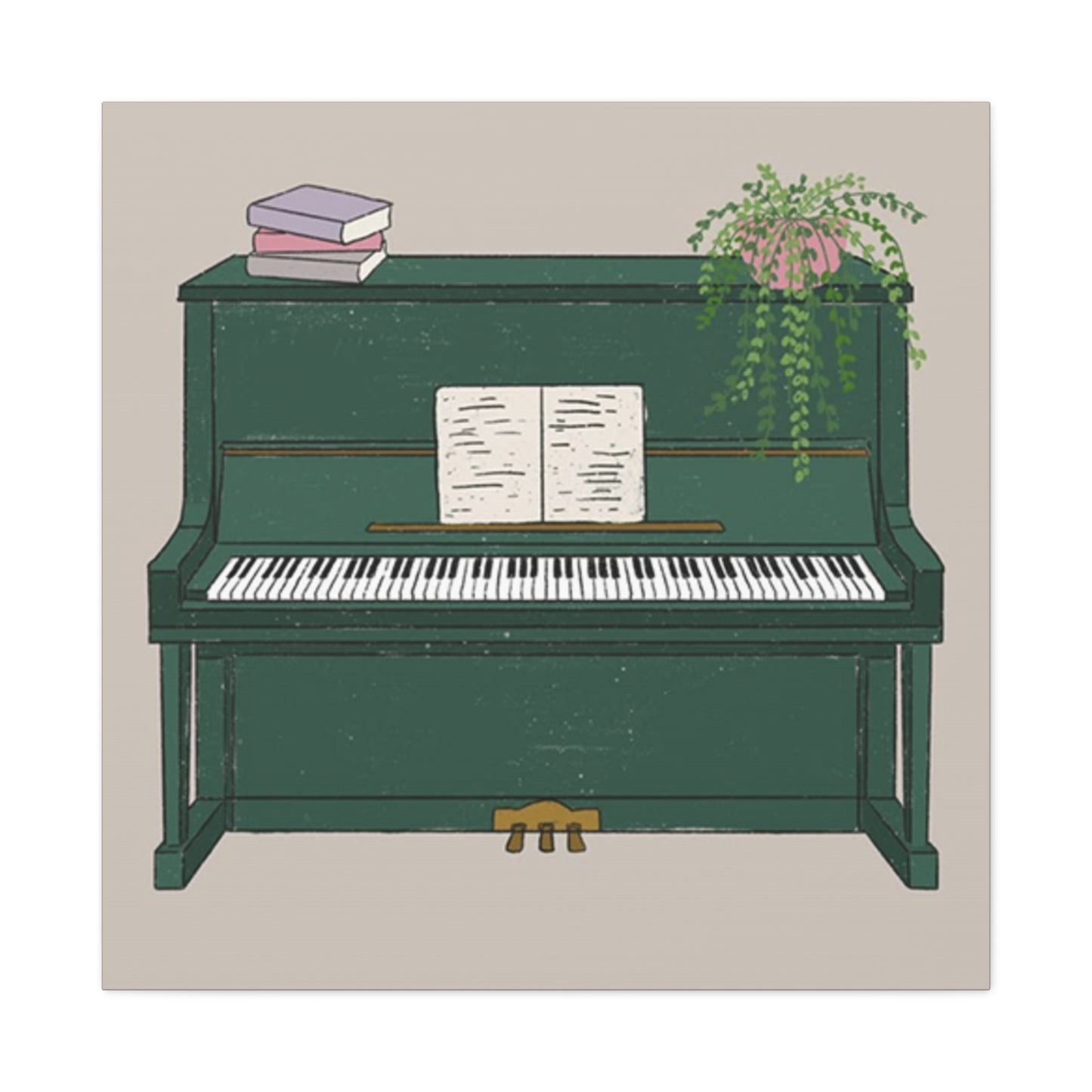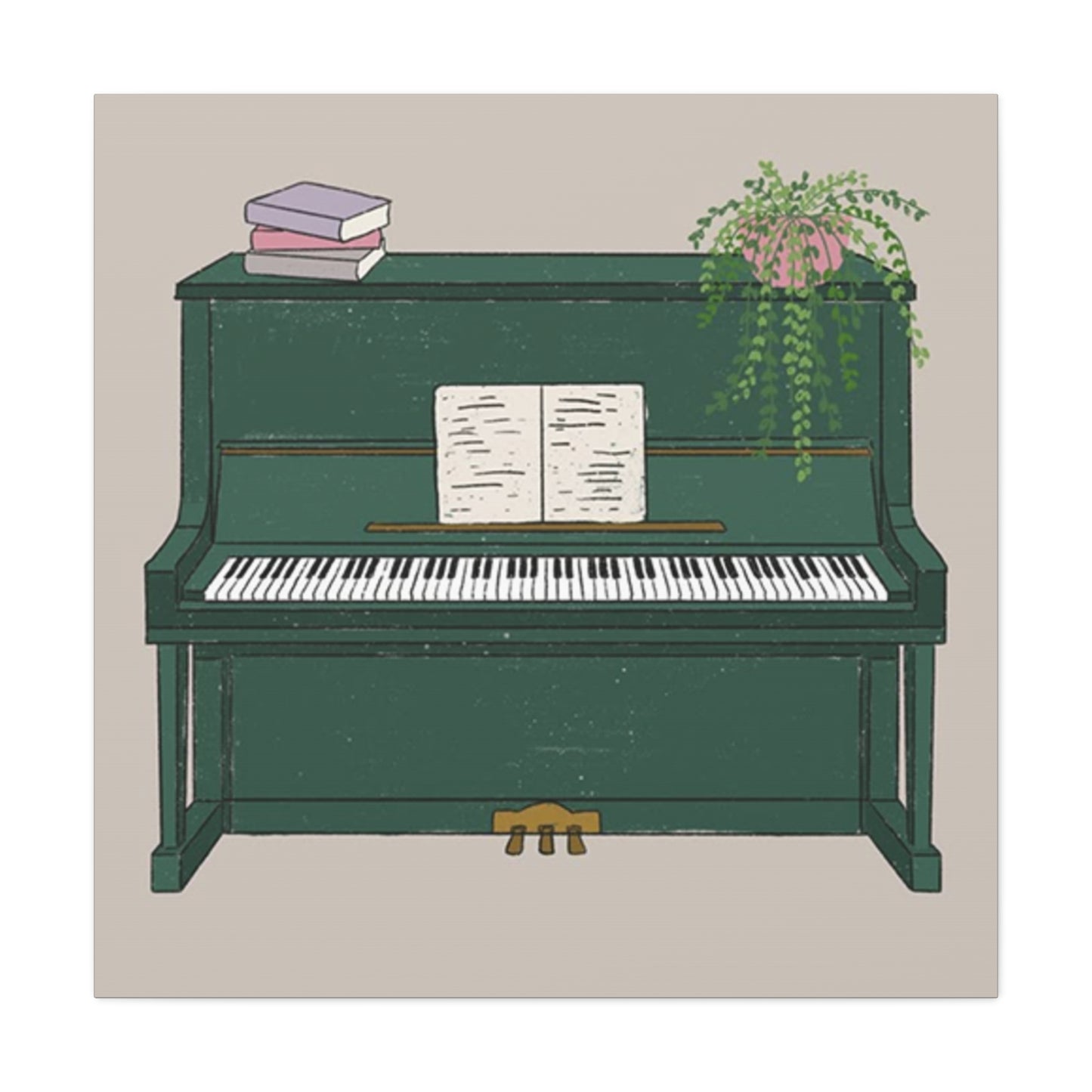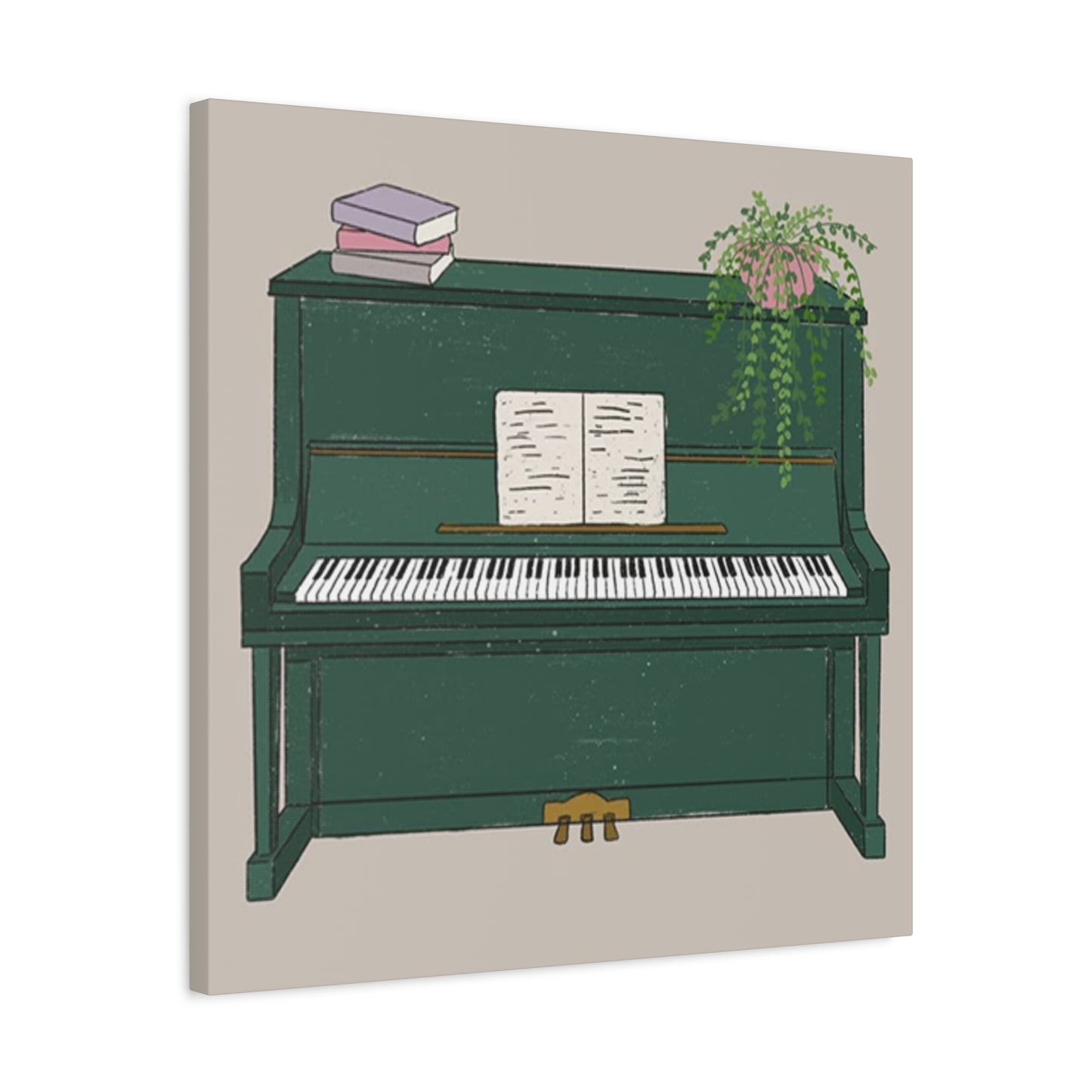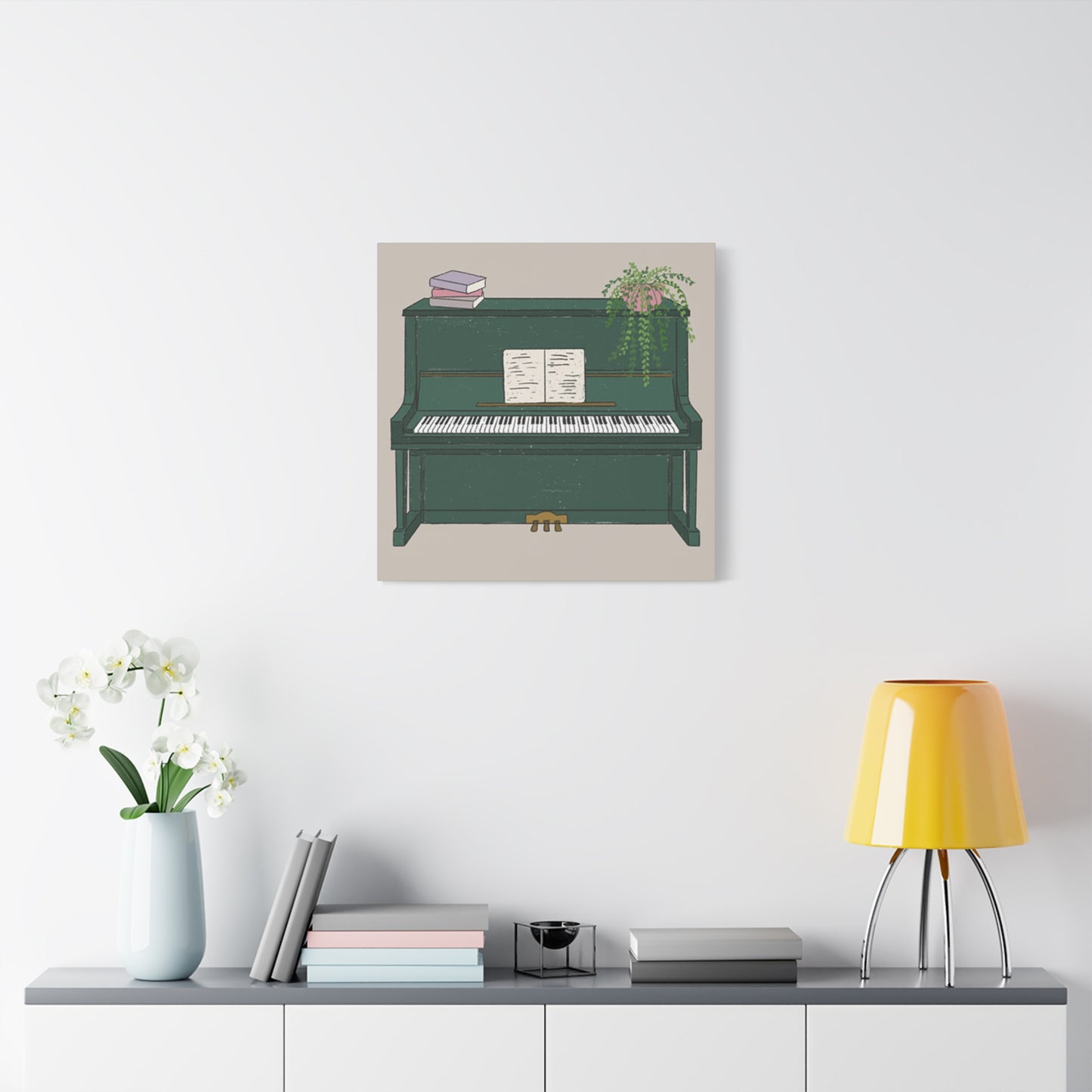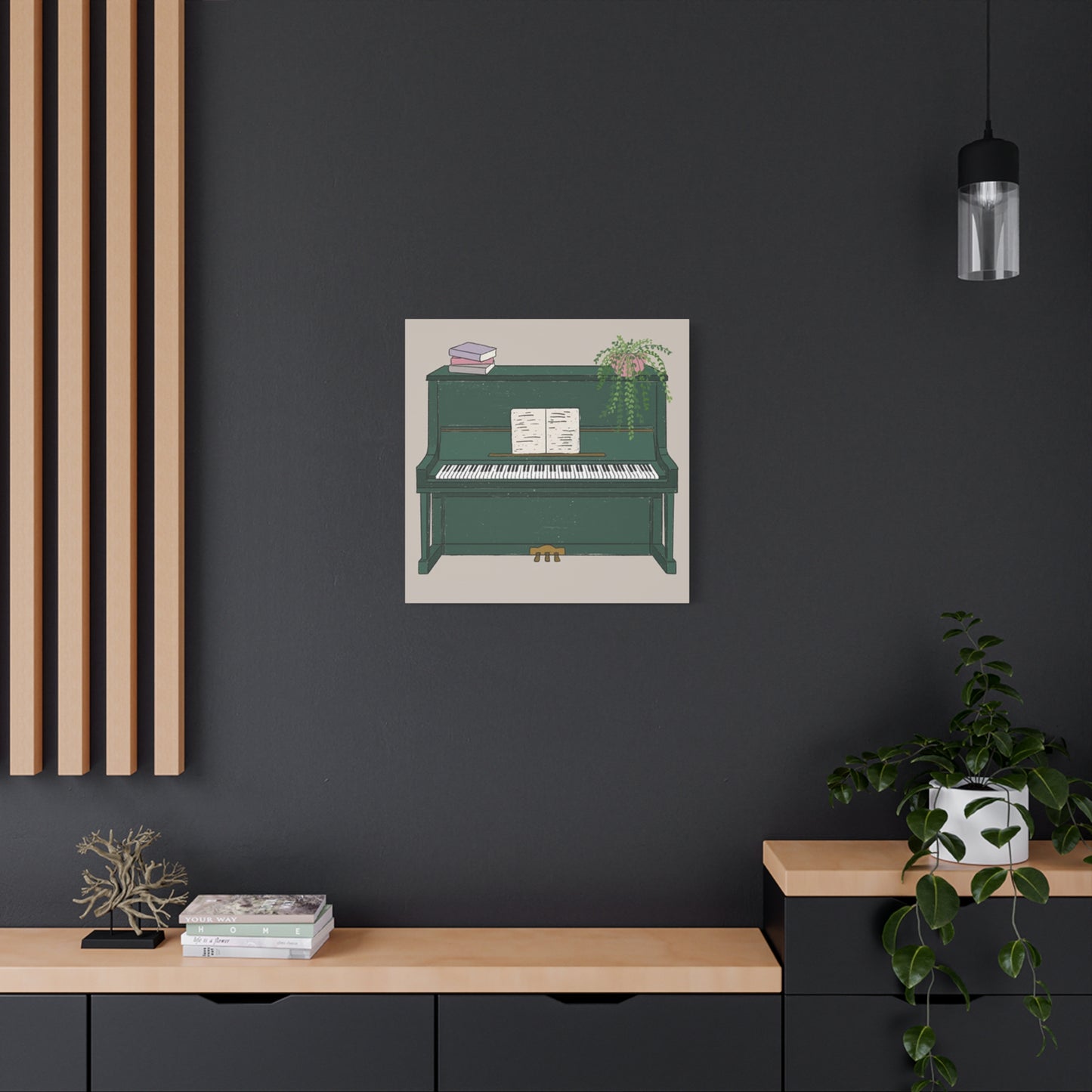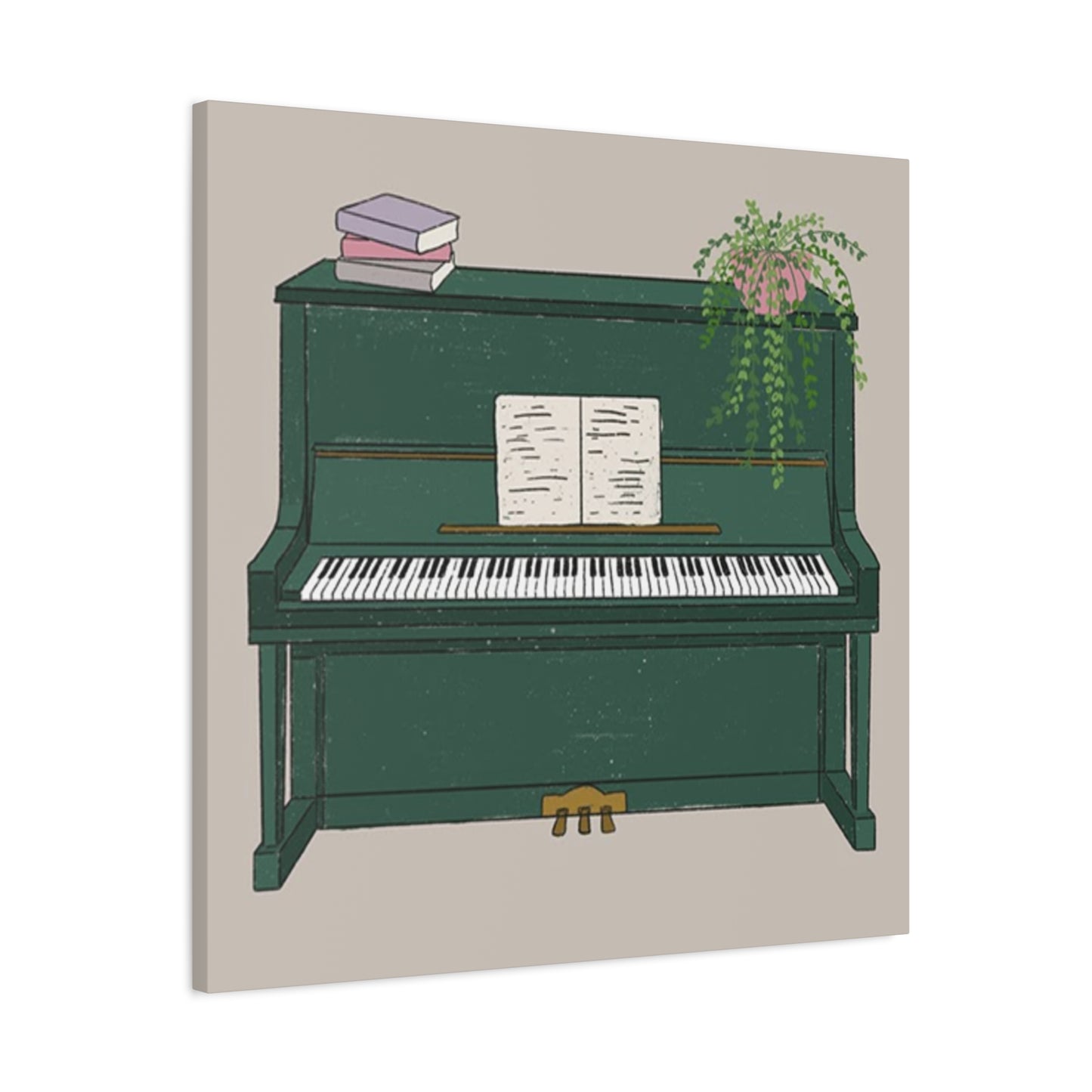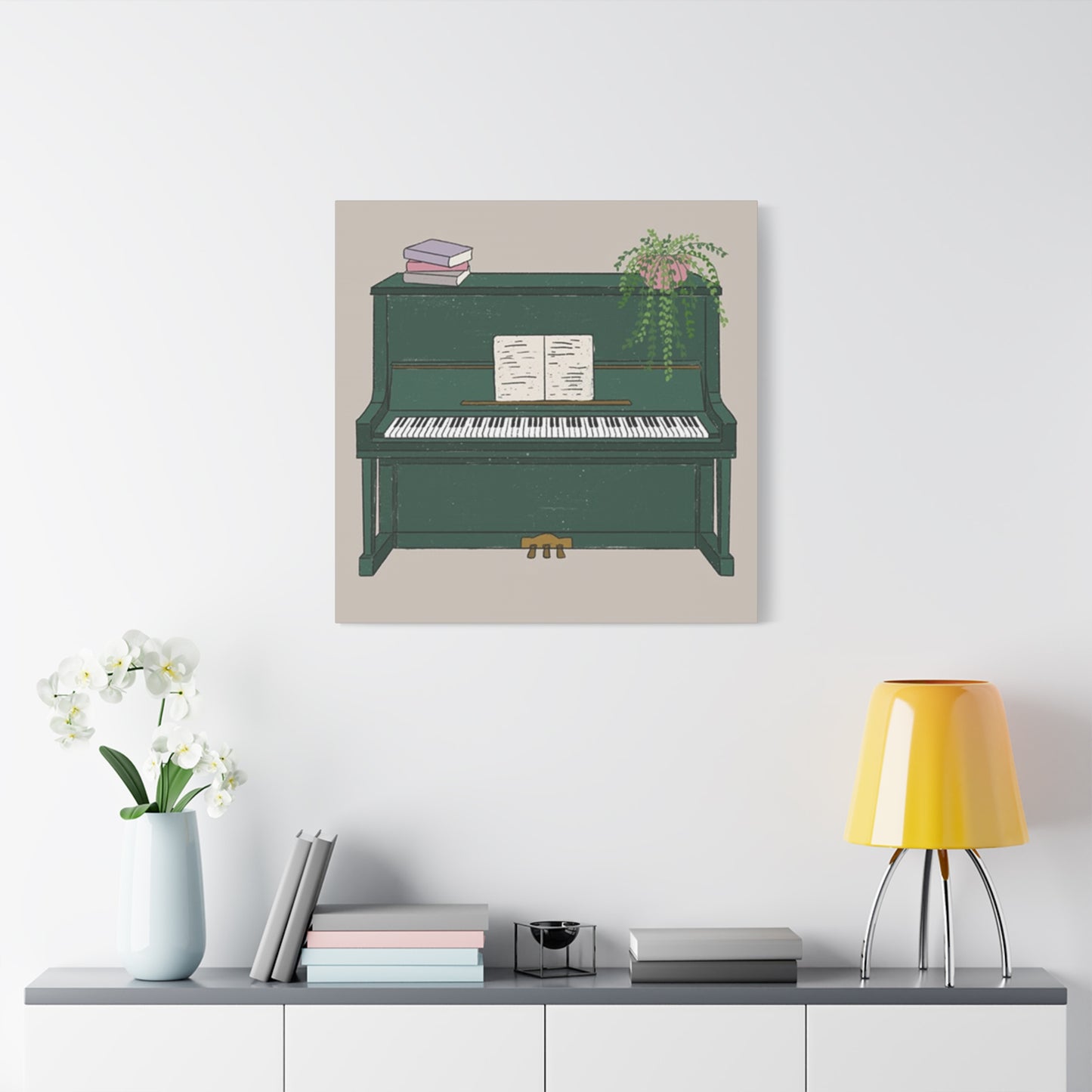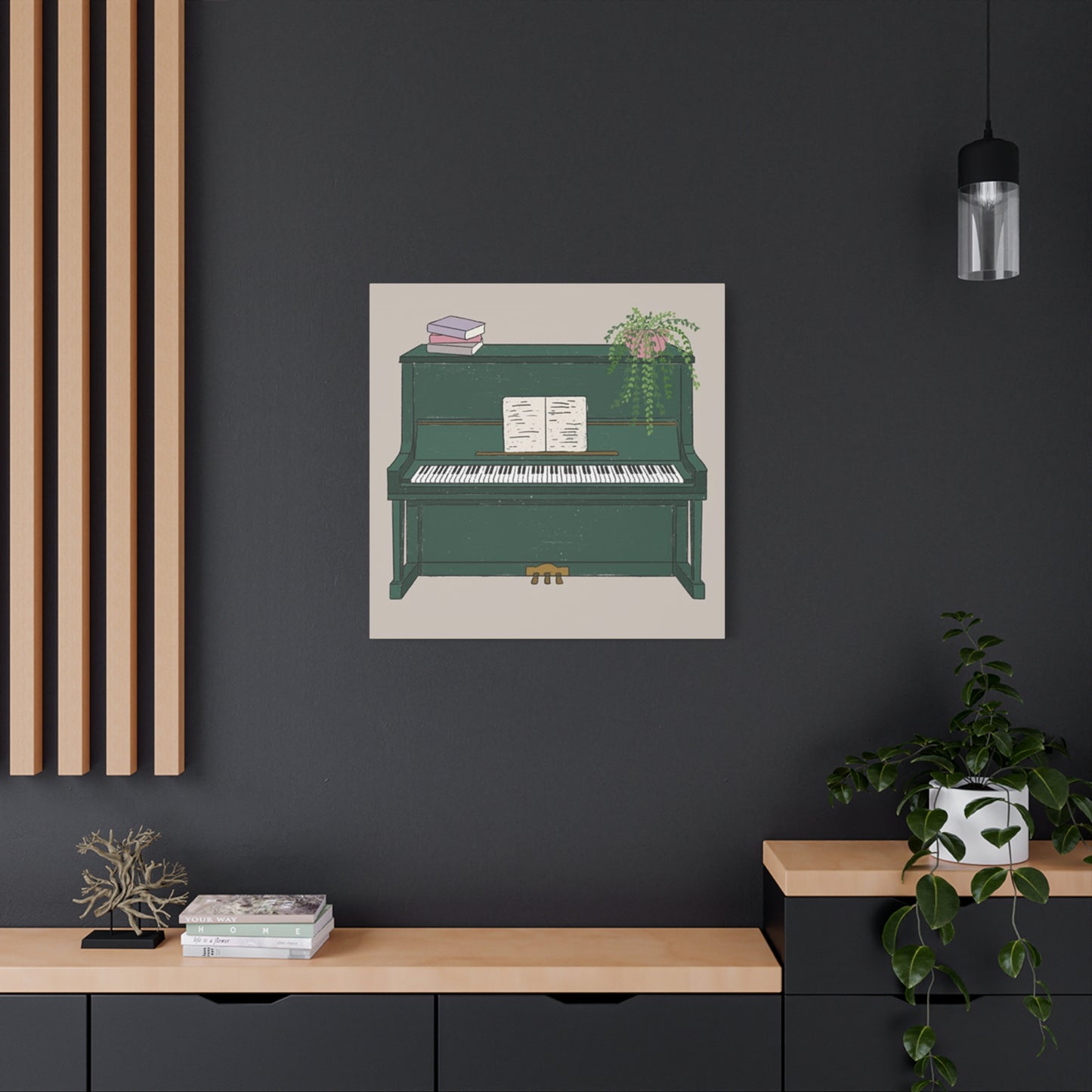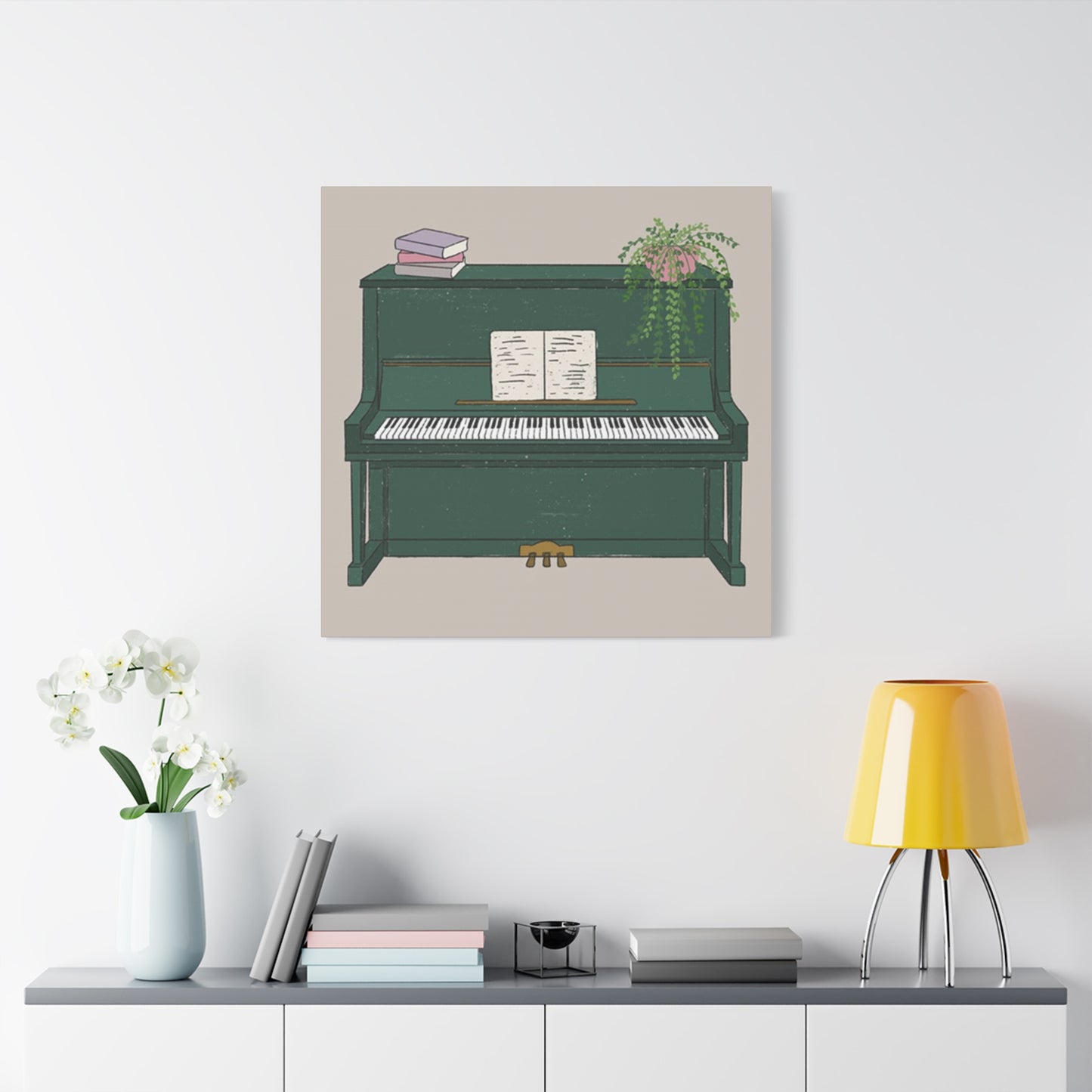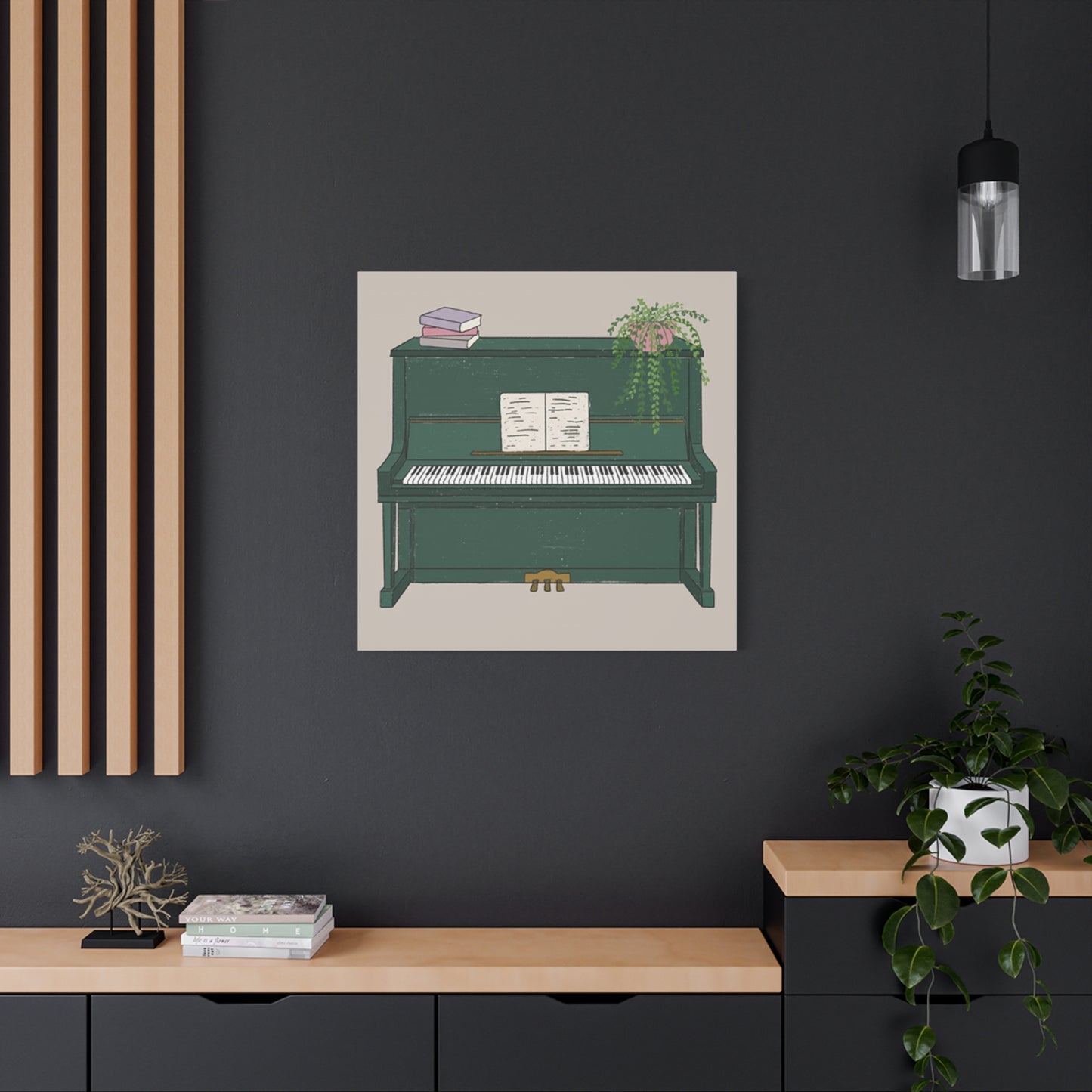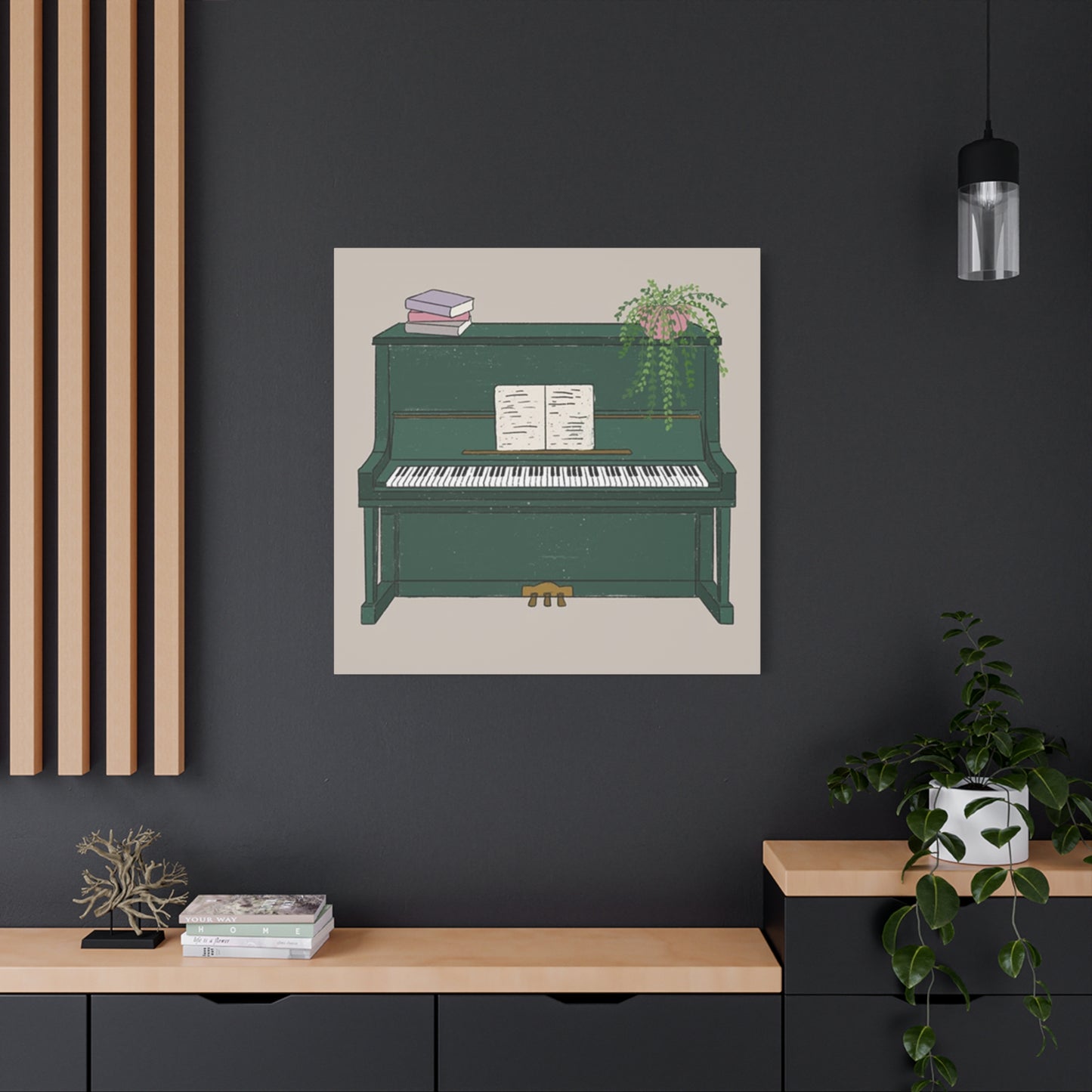Green Piano Wall Art: Harmonizing Musical Elegance with Natural Beauty
Green piano wall art represents a captivating fusion of musical sophistication and natural tranquility, creating visual masterpieces that resonate with both music lovers and art enthusiasts. This unique artistic expression combines the timeless elegance of pianos with the refreshing, calming qualities of green hues, resulting in decorative pieces that can transform any room into a harmonious sanctuary. Whether you're a professional musician, an art collector, or someone who simply appreciates the finer things in life, green piano wall art offers an exceptional way to infuse your living areas with both cultural depth and aesthetic appeal.
The emergence of green piano wall art as a popular decorative trend reflects our growing desire to connect with nature while celebrating human creativity. Green, as a color, has long been associated with growth, harmony, and renewal, making it an ideal complement to the piano's representation of musical expression and artistic achievement. When these two elements converge in wall art, they create a powerful visual statement that speaks to our deepest appreciation for both natural beauty and cultural refinement.
This comprehensive exploration delves into the multifaceted world of green piano wall art, examining everything from large-scale statement pieces to intimate artistic interpretations. We'll discover how these remarkable artworks can enhance various environments, from professional music studios to cozy home libraries, and learn about the techniques and considerations that make each piece truly special. The journey through this artistic landscape will reveal not only the aesthetic possibilities but also the emotional and psychological impacts these pieces can have on viewers and inhabitants alike.
Large-Scale Green Piano Drawings for Statement Walls
Creating impactful visual experiences through large-scale green piano drawings requires careful consideration of both artistic technique and environmental integration. These substantial artworks serve as focal points that can completely transform the atmosphere of a room, commanding attention while maintaining the sophisticated elegance that piano imagery naturally conveys. The scale of these pieces allows for intricate detail work that can capture every nuance of the piano's form, from the graceful curves of a grand piano's body to the precise geometry of the keyboard's black and white keys.
When designing large-scale green piano drawings, artists often employ various shading techniques to create depth and dimension that would be impossible to achieve in smaller formats. The expansive canvas allows for the exploration of multiple green tones, from deep forest greens that suggest mystery and depth to lighter sage greens that evoke tranquility and openness. These tonal variations can be strategically placed to highlight different aspects of the piano's architecture, creating visual interest that draws viewers in for closer examination while maintaining impact from across the room.
The technical challenges of creating large-scale green piano drawings extend beyond simple size considerations. Artists must maintain consistency in their line work and shading across the entire piece, ensuring that the drawing remains cohesive despite its impressive dimensions. This requires not only skill but also careful planning and often the use of specialized tools designed for large-format artwork. Many artists create detailed preliminary sketches and use grid systems to ensure accurate proportions when scaling up their designs.
Large-scale green piano drawings often incorporate environmental elements that complement the musical theme while enhancing the green color palette. Subtle botanical motifs, flowing musical notes rendered in varying shades of green, or abstract patterns that suggest both natural growth and musical rhythm can add layers of meaning and visual interest to these impressive works. These additional elements must be balanced carefully to avoid overwhelming the central piano image while still contributing to the overall compositional strength.
The placement of large-scale green piano drawings requires strategic thinking about room dynamics and viewing angles. These pieces work exceptionally well in rooms with high ceilings, where their vertical presence can be fully appreciated without overwhelming the available wall area. Living rooms, music rooms, and formal dining areas are ideal locations for such statement pieces, as they provide the necessary viewing distance and appropriate context for appreciation.
Lighting considerations become particularly important with large-scale green piano drawings, as the expansive surface area can create dramatic effects when properly illuminated. Natural light can bring out the subtle variations in green tones throughout the day, while carefully positioned artificial lighting can create depth and highlight specific areas of the drawing during evening hours. The interplay between light and shadow across the large surface can transform the artwork throughout the day, providing an ever-changing visual experience.
The psychological impact of large-scale green piano drawings cannot be understated. These substantial artworks create a sense of grandeur and cultural sophistication that can elevate the entire atmosphere of a room. The combination of the piano's association with classical refinement and green's calming, natural properties creates an environment that feels both inspiring and peaceful. Viewers often report feeling a sense of calm focus when in the presence of these large-scale pieces, making them particularly effective in areas designated for contemplation or creative work.
Creating custom large-scale green piano drawings allows for personalization that can make these statement pieces even more meaningful. Artists can incorporate specific piano models, particular shade preferences, or even subtle personal elements that reflect the commissioner's individual taste and musical journey. This customization process often involves detailed consultation to ensure that the finished piece will integrate seamlessly with the intended environment while reflecting the owner's unique aesthetic vision.
The investment value of high-quality large-scale green piano drawings extends beyond their immediate decorative impact. These pieces often appreciate in value, particularly when created by recognized artists or when they represent significant artistic innovation within the genre. The substantial size and specialized nature of these works make them distinctive additions to any art collection, with the potential for long-term appreciation both aesthetically and financially.
Framing Tips for Green Piano Prints
Selecting the appropriate frame for green piano prints requires understanding how different framing options can enhance or detract from the artwork's inherent beauty and intended impact. The frame serves as the crucial transition between the artwork and its surrounding environment, making it essential to choose options that complement both the green color palette and the sophisticated nature of piano imagery. Professional framing can elevate even simple prints into gallery-worthy presentations that command respect and admiration.
The choice of frame material significantly impacts how green piano prints are perceived and appreciated. Wood frames offer natural warmth that harmonizes beautifully with green tones, particularly when selecting species like oak, walnut, or cherry that provide rich, complementary colors. The grain patterns in wood frames can echo the organic qualities suggested by green hues while maintaining the refined elegance that piano art demands. Different wood finishes, from natural oils to sophisticated stains, can be selected to either blend seamlessly with the artwork or provide subtle contrast that enhances visual interest.
Metal frames present a more contemporary approach to framing green piano prints, offering clean lines and modern sophistication that can appeal to those with minimalist aesthetic preferences. Silver and brushed aluminum frames work particularly well with cooler green tones, while warmer metals like bronze or copper can complement earthier green shades. The sleek appearance of metal frames allows the artwork to take center stage while providing a refined border that suggests contemporary musical interpretations and modern artistic sensibilities.
Matting considerations play a crucial role in presenting green piano prints effectively. White and cream mats provide classic, neutral backgrounds that allow the green tones to appear vibrant and true to the artist's original vision. However, more adventurous matting choices can create dramatic effects that enhance the artwork's impact. Subtle gray mats can provide sophisticated contrast, while carefully selected green mats in complementary shades can create layered color effects that add depth and visual richness to the overall presentation.
The width of the mat border affects how viewers perceive the scale and importance of green piano prints. Wider mats create a sense of luxury and importance, making even smaller prints appear more substantial and gallery-worthy. This approach works particularly well for vintage-style green piano prints or those with classical artistic treatments. Narrower mats maintain focus on the artwork itself while providing necessary separation from the frame, making them ideal for modern interpretations or when displaying multiple prints in series.
Glass selection represents another critical aspect of professional framing for green piano prints. Regular glass provides basic protection while maintaining clear visibility, but upgrade options can significantly enhance the viewing experience. Museum-quality glass eliminates reflections that might obscure details in the artwork, while UV-filtering glass protects the prints from harmful light exposure that could fade the green pigments over time. Non-glare glass can be beneficial in rooms with challenging lighting conditions, though it may slightly affect color perception.
Conservation framing techniques become important considerations for valuable green piano prints or those intended as long-term investments. Acid-free matting materials prevent chemical reactions that could damage the artwork over time, while proper spacing techniques ensure that the print never comes into direct contact with the glass. These conservation approaches may represent additional investment upfront but provide crucial protection that maintains the artwork's condition and value over decades.
Custom framing options allow for creative solutions that perfectly complement specific green piano prints and their intended environments. Double matting techniques can create sophisticated layered effects, while specialty mounting options can accommodate unusual print sizes or artistic presentations. Custom frame profiles can be designed to echo architectural elements in the room or to reflect the specific style of piano depicted in the artwork.
The relationship between frame size and wall placement requires careful consideration to achieve optimal visual impact. Oversized frames can overwhelm smaller prints, while insufficient framing may cause substantial artworks to appear diminished. Professional framers often recommend viewing framed samples in similar lighting conditions to those where the artwork will be displayed, ensuring that the final presentation will achieve the desired effect in its permanent location.
Grouping multiple green piano prints requires coordinated framing approaches that create visual harmony while allowing each piece to maintain its individual character. Matching frames can create formal, gallery-like presentations, while varied framing approaches within a consistent theme can provide visual interest and dynamic energy. The spacing between frames and their alignment on the wall becomes crucial for creating successful groupings that enhance rather than compete with each other.
Budget considerations for framing green piano prints can range from simple, cost-effective solutions to elaborate custom treatments. Understanding the hierarchy of framing elements helps prioritize investments where they will have the greatest impact. Professional consultation can provide guidance on achieving maximum visual effect within specific budget constraints, often identifying creative solutions that provide excellent results without unnecessary expense.
Green Piano Art for Music Rooms
Designing music rooms with green piano art creates environments that celebrate both musical achievement and natural harmony, resulting in surroundings that inspire creativity while providing the tranquil atmosphere necessary for focused practice and performance. These specialized environments require careful consideration of how artwork interacts with acoustics, lighting, and the functional needs of musicians, creating challenges and opportunities unique to music-focused rooms.
The acoustic properties of music rooms significantly influence how green piano art should be selected and positioned. Hard surfaces necessary for optimal sound projection can create visual starkness that green piano art can effectively soften without compromising acoustic performance. The organic curves and flowing lines typical of piano imagery help break up harsh geometric angles that might create unwanted sound reflections, while the calming influence of green tones can reduce the visual fatigue that sometimes accompanies intensive practice sessions.
Scale considerations become particularly important when selecting green piano art for music rooms, as these environments often contain large instruments that could overwhelm smaller artworks. The presence of an actual piano in the room creates unique opportunities for visual harmony between the three-dimensional instrument and two-dimensional artistic representations. Green piano art can echo the piano's form while providing color contrast that prevents visual monotony, creating a layered aesthetic experience that celebrates the instrument from multiple artistic perspectives.
Lighting design in music rooms requires balancing the needs of musicians with the optimal presentation of green piano art. Task lighting for music reading must be carefully positioned to avoid creating glare on artwork surfaces, while accent lighting can highlight specific pieces to create visual interest during performance breaks. The interplay between functional and aesthetic lighting can be designed to create different moods appropriate for practice sessions versus performance situations.
The psychological benefits of incorporating green piano art in music rooms extend beyond simple decoration to influence musical performance and creativity. Green's association with growth and renewal can inspire musicians to approach their practice with fresh perspectives, while the familiar imagery of pianos can reinforce their connection to their chosen instrument. Students often report feeling more motivated and focused when surrounded by artwork that celebrates their musical pursuits.
Storage and display considerations in music rooms require creative solutions that accommodate both artistic presentation and practical needs. Sheet music, instrument accessories, and recording equipment must coexist with artwork in ways that maintain the room's aesthetic appeal while ensuring functionality. Custom display solutions can integrate green piano art with functional elements, creating cohesive designs that serve multiple purposes without compromise.
Green piano art can be strategically positioned to define different functional zones within larger music rooms. Practice areas might feature more energizing green tones that promote focus and activity, while listening areas could incorporate softer, more contemplative shades that encourage relaxation and appreciation. This zoning approach through artistic selection can help musicians and guests understand the intended use of different room areas without requiring explicit signage or barriers.
The durability of green piano art in music rooms requires consideration of the unique environmental conditions these areas often experience. Temperature fluctuations from heating and cooling systems, humidity changes, and potential vibrations from musical instruments can all affect artwork longevity. Selecting appropriate materials and protective measures ensures that green piano art will continue to enhance the music room for years to come.
Creating gallery walls of green piano art in music rooms allows for the display of diverse artistic interpretations while maintaining thematic coherence. Different artistic styles, from realistic renderings to abstract interpretations, can coexist when unified by the green color palette and piano imagery. This approach provides visual interest that can inspire creativity while avoiding the monotony that might result from too uniform an artistic approach.
Seasonal rotation of green piano art can keep music room environments fresh and inspiring throughout the year. Different shades and styles of green piano art can reflect changing seasons while maintaining the room's overall aesthetic coherence. This approach prevents visual stagnation and can provide musicians with new sources of inspiration as their artistic development progresses.
The educational value of thoughtfully selected green piano art in music rooms should not be overlooked. Historical piano illustrations can provide context for musical development, while contemporary artistic interpretations can demonstrate the ongoing relevance and evolution of piano music. Young musicians particularly benefit from environments that celebrate their chosen instrument through diverse artistic expressions.
Integration with technology in modern music rooms requires considering how green piano art interacts with recording equipment, digital displays, and other electronic components. Artwork placement must accommodate cable management and equipment access while maintaining aesthetic appeal. Smart solutions can even incorporate digital green piano art displays that can be updated and changed to match different musical projects or seasonal preferences.
Modern Interpretations of Piano Drawings in Green
Contemporary artists continue to reimagine traditional piano imagery through fresh perspectives that incorporate green color palettes in innovative and unexpected ways. These modern interpretations challenge conventional representations while maintaining the essential character that makes piano art recognizable and emotionally resonant. The evolution of artistic techniques and conceptual approaches has opened new possibilities for expressing the relationship between music and visual art through the lens of natural color harmony.
Abstract expressionist approaches to green piano art eliminate literal representation in favor of emotional and conceptual connections to musical instruments. These interpretations might suggest the flow of music through organic green forms, or capture the emotional resonance of piano music through bold gestural strokes in various green hues. The resulting artworks speak to the feeling of piano music rather than its physical manifestation, creating pieces that resonate with viewers on intuitive rather than intellectual levels.
Minimalist interpretations of green piano art strip away unnecessary details to focus on essential forms and relationships. Clean lines, geometric shapes, and carefully selected green tones create sophisticated compositions that suggest piano presence without explicit representation. These approaches appeal to contemporary aesthetic sensibilities while maintaining the contemplative qualities that make piano imagery so enduringly popular.
Digital art techniques have opened unprecedented possibilities for creating green piano art that would be impossible through traditional media. Layering effects, gradient manipulations, and digital texturing can create depth and visual interest that enhance the natural beauty of green color palettes. These technical capabilities allow artists to explore new relationships between color, form, and musical inspiration that push the boundaries of traditional artistic expression.
Mixed media approaches combine traditional drawing or painting techniques with collage elements, textural additions, or three-dimensional components to create green piano art that engages multiple senses. These pieces might incorporate actual sheet music, piano wire, or natural elements like leaves or wood that reinforce the connection between the green color palette and natural themes. The tactile qualities of mixed media can make these artworks particularly engaging for viewers who appreciate hands-on artistic experiences.
Photorealistic digital rendering techniques allow artists to create green piano art with unprecedented detail and precision. Every reflection, shadow, and textural nuance can be controlled and perfected, resulting in images that can appear more vivid and immediate than traditional photography. These approaches often incorporate fantastical elements, such as pianos growing from natural landscapes or musical notes transforming into botanical forms, that would be impossible to capture through conventional means.
Street art and graffiti influences have brought green piano art into urban contexts with bold, energetic interpretations that speak to contemporary cultural movements. These pieces often incorporate spray paint techniques, stenciling, and urban imagery that connects classical musical instruments with modern city life. The juxtaposition of refined piano imagery with raw urban aesthetics creates dynamic tension that reflects the diverse role music plays in contemporary society.
Installation art concepts applied to green piano art create immersive experiences that surround viewers with musical and natural imagery. Large-scale environmental pieces might fill entire rooms with green piano imagery, creating spaces where the boundaries between art and environment dissolve. These installations often incorporate sound elements, lighting effects, or interactive components that allow viewers to influence the artistic experience through their presence and actions.
Conceptual art approaches to green piano art focus on ideas and meanings rather than traditional aesthetic concerns. These pieces might explore themes like environmental sustainability in music production, the relationship between natural and artificial sound creation, or the cultural significance of piano music across different societies. The green color palette becomes a vehicle for exploring deeper philosophical and social questions related to music and nature.
Surrealist influences in modern green piano art create dreamlike compositions that challenge logical relationships and create new emotional associations. Pianos might sprout branches and leaves, musical notes could transform into flying birds, or keyboard keys might extend into infinite natural landscapes. These fantastical elements encourage viewers to reconsider their assumptions about both music and visual art while providing rich material for contemplation and interpretation.
Pop art sensibilities applied to green piano art often result in bold, commercially influenced pieces that celebrate popular culture's relationship with music. Bright green color schemes, repetitive imagery, and graphic design elements create accessible artwork that appeals to broad audiences while maintaining sophisticated artistic merit. These approaches often incorporate humor, irony, or social commentary that reflects contemporary attitudes toward music and artistic expression.
Technology integration in modern green piano art includes augmented reality features, interactive digital components, or smart display capabilities that allow artworks to change and evolve over time. These technological enhancements can respond to musical input, environmental conditions, or viewer interaction, creating dynamic artistic experiences that reflect the ever-changing nature of musical performance itself.
DIY Green Piano Wall Art Projects
Creating personalized green piano wall art through do-it-yourself projects offers opportunities for artistic expression while developing practical skills and creating meaningful decorations that reflect individual taste and creativity. These projects can range from simple techniques suitable for beginners to complex undertakings that challenge experienced crafters, providing accessible entry points for anyone interested in combining musical themes with natural color palettes in their home decoration.
Basic drawing and painting techniques form the foundation for many successful DIY green piano wall art projects. Starting with simple pencil sketches allows creators to develop confidence with piano proportions and forms before adding color elements. Watercolor paints provide an ideal medium for exploring different green tones and creating subtle gradations that capture the organic qualities associated with natural green hues. The translucent nature of watercolors allows for layering techniques that can create depth and luminosity in finished pieces.
Acrylic painting techniques offer more permanent and vibrant results for DIY green piano wall art projects. The quick-drying nature of acrylics allows for rapid experimentation with different approaches, while their opacity enables bold color statements and precise detail work. Mixing custom green shades becomes an enjoyable part of the creative process, allowing artists to develop personalized color palettes that perfectly match their decorative vision and room requirements.
Collage techniques provide accessible approaches to creating green piano wall art without requiring advanced drawing skills. Sheet music, magazine clippings, fabric scraps, and natural materials can be combined to create textural compositions that celebrate both musical and natural themes. The layering possibilities in collage work allow for complex compositions that develop over time as new elements are added and refined.
Stenciling techniques offer precision and repeatability for DIY green piano wall art projects, making them ideal for creators who prefer structured approaches to artistic expression. Custom stencils can be created from cardboard or purchased commercially, then used with various green paint shades to create clean, professional-looking results. Multiple stencil layers can create complex compositions with precise registration and consistent quality.
Digital creation and printing opens possibilities for DIY green piano wall art that leverages technology without requiring traditional artistic skills. Digital drawing programs allow for unlimited experimentation with compositions and color schemes, while high-quality home printing enables the production of professional-looking results. This approach particularly appeals to those comfortable with technology who want to create custom artwork without investing in traditional art supplies.
Fabric-based DIY green piano wall art projects can incorporate sewing, embroidery, or fabric painting techniques to create unique textural experiences. These projects often result in artwork with dimensional qualities that add visual interest and tactile appeal. Quilting techniques can be adapted to create piano imagery using various green fabrics, while embroidery allows for detailed linear work that captures piano details with thread rather than paint.
Photography-based DIY projects can create green piano wall art by capturing and manipulating images of actual pianos, natural environments, or abstract compositions that suggest musical themes. Photo editing software allows for color manipulation that can transform ordinary photographs into striking green-toned artistic statements. Multiple images can be combined to create composite artworks that would be impossible to capture through single photographs.
Three-dimensional DIY green piano wall art projects incorporate sculptural elements that extend beyond traditional flat artwork presentations. These might include relief compositions, shadow box presentations, or assemblage works that combine various materials and objects. The dimensional aspect adds visual interest and can create dramatic shadow effects that change throughout the day as lighting conditions evolve.
Upcycling and recycling approaches to DIY green piano wall art promote environmental sustainability while creating unique artistic expressions. Old sheet music, discarded piano parts, or natural materials can be transformed into meaningful artwork that celebrates both creativity and environmental responsibility. These projects often tell stories through their material choices, adding layers of meaning beyond their immediate visual appeal.
Group and family DIY green piano wall art projects can create collaborative artworks that involve multiple participants and skill levels. These projects might include community art initiatives, family creative sessions, or classroom activities that celebrate both individual expression and collaborative achievement. The social aspects of group projects often enhance the enjoyment and meaning of the final artworks.
Seasonal DIY green piano wall art projects can be designed for easy updating and modification, allowing room decorations to reflect changing seasons while maintaining core themes. Interchangeable elements, removable components, or modular designs enable ongoing customization without requiring complete reconstruction. This approach keeps living environments fresh and engaging while building upon previous creative investments.
Advanced DIY techniques for experienced creators might include complex mixed media approaches, innovative material applications, or technical challenges that develop new skills and artistic capabilities. These projects can serve as stepping stones toward more professional artistic pursuits while maintaining the personal satisfaction that comes from hands-on creation and problem-solving.
The Symbolism of Green in Music Art
The profound symbolic associations between green hues and musical artistic expression create rich layers of meaning that enhance the emotional and intellectual impact of green piano wall art. Understanding these symbolic relationships deepens appreciation for these artworks while providing insight into why certain color and subject combinations resonate so powerfully with viewers across cultures and artistic traditions.
Growth and renewal represent perhaps the most fundamental symbolic associations with green in musical contexts. Just as plants grow and flourish in natural cycles, musical abilities develop through practice and dedication, creating parallel narratives of development and achievement. Green piano art often serves as visual reminder of the ongoing journey of musical learning, suggesting that artistic progress, like natural growth, requires patience, nurturing, and time to reach full potential.
Harmony and balance emerge as central themes when green color symbolism intersects with piano imagery. The piano's role as a harmonic foundation instrument mirrors green's position as a balanced color that sits between the warm and cool spectrums. This symbolic alignment creates artwork that suggests both musical and visual equilibrium, making green piano art particularly suitable for environments where peace and stability are desired.
Natural creativity and organic inspiration connect green's environmental associations with the creative processes that drive musical composition and performance. Many composers throughout history have drawn inspiration from natural settings, and green piano art can serve as visual bridge between the natural world and musical expression. These symbolic connections suggest that music, like nature, follows organic patterns of development and expression that transcend artificial boundaries.
Hope and optimism characterize another important symbolic dimension of green in musical art. The fresh, vital qualities associated with green hues can inspire musicians and music lovers to approach their artistic pursuits with renewed enthusiasm and positive expectations. Green piano art can serve as visual encouragement, reminding viewers that musical journeys, despite their challenges, offer rewards and satisfaction that justify the effort required for mastery.
Fertility and abundance in green symbolism translate to musical contexts as richness of expression and limitless creative possibilities. The piano's extensive range and expressive capabilities mirror the abundance suggested by lush green imagery, creating artistic statements that celebrate both musical and natural profusion. These symbolic associations make green piano art particularly appropriate for spaces dedicated to composition and creative musical work.
Healing and restoration represent significant symbolic themes that connect green's traditional associations with wellness to music's therapeutic properties. Both music and green natural environments have documented positive effects on mental and physical health, making their combination in artwork particularly meaningful for therapeutic settings or personal retreat areas. Green piano art can serve as visual reminder of music's healing power.
Jealousy and envy, while less positive associations with green, can be thoughtfully incorporated into musical art that explores the competitive aspects of musical performance or the complex emotions that surround artistic achievement. These darker symbolic elements can add psychological depth to green piano art that addresses the full spectrum of musical experience, including its challenges and emotional complexities.
Cultural variations in green symbolism provide rich material for international interpretations of piano art that reflect diverse musical traditions and cultural perspectives. Irish cultural associations with green create different symbolic resonances than those found in Asian or African traditions, allowing green piano art to carry culture-specific meanings that enhance its relevance for different audiences and contexts.
Seasonal symbolism connects green's association with spring and new beginnings to musical themes of rebirth and artistic renewal. Green piano art can capture the optimistic energy of spring while celebrating music's power to refresh and revitalize human experience. These seasonal connections make such artwork particularly meaningful for musicians who experience cyclical patterns of inspiration and creativity.
Environmental consciousness and sustainability concerns in contemporary culture add modern symbolic layers to green piano art that address current social and environmental issues. These artworks can serve as statements about sustainable artistic practices, environmental awareness in music production, or the connection between natural preservation and cultural preservation. Such symbolic interpretations give green piano art relevance to contemporary social movements and concerns.
Spiritual and mystical associations with green in various religious and philosophical traditions can infuse piano art with deeper metaphysical meanings. These symbolic dimensions might explore music's role in spiritual practice, the connection between natural and divine creativity, or the transcendent qualities that both music and nature can provide to human experience. Such interpretations create artwork that functions on multiple levels of meaning and significance.
Using Green Piano Prints to Inspire Creativity
The strategic placement and thoughtful selection of green piano prints can create environments that actively stimulate creative thinking and artistic expression, transforming ordinary rooms into inspiring sanctuaries that encourage innovation and imaginative exploration. Understanding how visual art influences cognitive processes and creative output enables the purposeful use of these prints to maximize their inspirational potential across various creative disciplines and personal pursuits.
Color psychology research demonstrates that green hues can enhance focus and reduce eye strain, making them ideal choices for creative work areas where extended concentration is required. The calming yet energizing qualities of green create optimal conditions for the relaxed awareness that often characterizes peak creative states. Green piano prints can contribute to these beneficial psychological environments while providing subject matter that celebrates human creativity and artistic achievement.
Visual inspiration mechanisms operate through both conscious and subconscious pathways, with green piano prints serving as constant reminders of artistic possibility and musical expression. The presence of these images can trigger associative thinking patterns that connect musical concepts with other creative endeavors, fostering cross-disciplinary inspiration that enriches creative output across various fields. Writers, painters, designers, and other creative professionals often report enhanced productivity when surrounded by artwork that celebrates creativity in any form.
Environmental design principles for creative productivity emphasize the importance of visual variety and aesthetic pleasure in maintaining long-term motivation and engagement. Green piano prints provide sophisticated visual interest that can sustain attention without becoming distracting, creating backgrounds that support rather than compete with creative work. The balance between stimulation and tranquility that characterizes well-chosen green piano prints makes them ideal for environments where sustained creative effort is required.
Mood enhancement through carefully selected green piano prints can address the emotional fluctuations that often accompany creative work. The optimistic associations of green combined with the cultured sophistication of piano imagery can help maintain positive attitudes during challenging creative periods. These emotional benefits often translate directly into improved creative output and greater satisfaction with artistic pursuits.
Spatial psychology considerations reveal that green piano prints can influence how creators perceive and use their work environments. Prints that suggest depth and movement can make small areas feel more expansive, while those with strong compositional elements can provide visual anchors that help organize complex creative projects. Understanding these spatial effects enables strategic placement that maximizes both aesthetic appeal and functional benefit.
Memory and association techniques can be enhanced through the consistent presence of green piano prints that become linked with successful creative sessions. These visual cues can help trigger productive mental states and recall effective creative strategies, making them valuable tools for establishing and maintaining creative routines. The reliability of these visual triggers can provide stability and confidence during periods when creative inspiration feels elusive.
Collaborative creativity benefits from shared visual references that can facilitate communication and inspire group brainstorming. Green piano prints provide common aesthetic touchstones that can help team members align their creative visions while providing neutral starting points for creative discussions. The universal appeal of both music and natural beauty makes these prints effective choices for diverse creative groups.
Seasonal and temporal considerations in using green piano prints for creative inspiration might involve rotating selections to maintain visual freshness and respond to changing creative needs. Different green tones and artistic styles can reflect seasonal energy patterns or specific project requirements, ensuring that the visual environment continues to support rather than hinder creative development over time.
Personal resonance and individual preference play crucial roles in how green piano prints inspire creativity, suggesting that the most effective selections will reflect personal aesthetic preferences and creative interests. Understanding individual responses to different artistic styles, green hues, and compositional approaches enables personalized selections that maximize inspirational value for specific users and applications.
Creative ritual and routine development can incorporate green piano prints as consistent elements that signal the beginning of creative work periods or mark transitions between different types of creative activity. These visual cues can become important components of creative habits that enhance productivity and creative satisfaction over time. The ceremonial aspect of working in thoughtfully designed environments can elevate creative work from routine activity to meaningful practice.
Technology integration with green piano prints might include digital displays that can change to match specific creative projects or moods, providing dynamic visual inspiration that evolves with creative needs. These technological approaches can offer unlimited variety while maintaining the core benefits of green color palettes and piano imagery in supporting creative environments.
Green Piano Art as Gifts for Musicians
Selecting green piano art as gifts for musicians requires understanding both the recipient's musical background and personal aesthetic preferences, creating opportunities to demonstrate thoughtfulness while providing meaningful additions to their artistic environments. These gifts can range from simple prints suitable for students to sophisticated original artworks appropriate for professional musicians, with each selection reflecting the giver's appreciation for the recipient's musical journey and artistic dedication.
Professional musician considerations often involve selecting green piano art that reflects the sophistication and refinement associated with serious musical careers. These individuals typically appreciate artwork that demonstrates understanding of musical culture and artistic excellence, making high-quality prints or original pieces particularly appropriate choices. The visual connection between their professional identity and their personal environment can provide ongoing affirmation of their artistic achievements and aspirations.
Student musician gifts require different approaches that acknowledge their developing skills while encouraging continued growth and dedication. Green piano art can serve as inspiration and motivation during challenging practice periods, providing visual reminders of musical beauty and artistic possibility. Affordable options that maintain artistic quality allow for meaningful gift-giving without excessive expense, making them accessible for teachers, parents, or fellow students who want to show support and encouragement.
Music teacher appreciation through green piano art gifts acknowledges their crucial role in developing musical talent and sharing cultural knowledge. These professionals often display student achievements and musical memorabilia in their studios, making thoughtfully selected green piano art valuable additions to their teaching environments. The combination of personal appreciation and practical utility makes such gifts particularly meaningful for educators who dedicate their careers to musical instruction.
Collector preferences among serious music enthusiasts often include specific artistic styles, historical periods, or technical approaches that make gift selection more challenging but potentially more rewarding. Understanding a collector's existing collection and aesthetic preferences enables the selection of green piano art that complements their established taste while adding new dimensions to their artistic holdings. These gifts can represent significant investments that appreciate over time while providing ongoing aesthetic pleasure.
Retirement gifts for music professionals might emphasize green piano art that celebrates career achievements while providing beautiful additions to residential environments where they will spend increased time. The transition from professional to personal environments often involves different aesthetic considerations, with green piano art offering connections to musical careers while fitting comfortably into home decorating schemes.
Memorial and tribute applications for green piano art can honor deceased musicians or mark significant musical milestones in respectful and beautiful ways. The combination of musical tribute with natural, life-affirming color symbolism creates appropriate artistic statements for these sensitive situations. Custom options might incorporate specific musical references or personal details that enhance the memorial significance.
Wedding and anniversary gifts can celebrate couples who share musical interests or where one partner is particularly involved in musical activities. Green piano art can represent harmony and growth in relationships while acknowledging shared cultural interests and artistic appreciation. These gifts often become lasting symbols of important life events that gain sentimental value over time.
Holiday and seasonal giving opportunities for green piano art might emphasize specific color tones or artistic styles that reflect particular celebrations or cultural traditions. The versatility of green hues allows for selections that feel appropriate for various holidays while maintaining year-round appeal and relevance. Understanding cultural and personal holiday preferences enables more thoughtful and meaningful gift selections.
Custom commissioning options for green piano art gifts provide opportunities to create unique pieces that perfectly reflect the recipient's interests, achievements, or personal style. These special projects might incorporate specific piano models, musical compositions, or personal elements that make the artwork uniquely meaningful. While requiring more time and investment, commissioned pieces often become treasured possessions that provide lasting satisfaction.
Presentation and packaging considerations for green piano art gifts can enhance their impact and demonstrate additional thoughtfulness in gift-giving. Professional framing, elegant wrapping, or accompaniment with related items like books about piano music or recordings can create complete gift experiences that extend beyond the artwork itself. These additional touches often make significant differences in how gifts are received and appreciated.
Budget-conscious approaches to green piano art gifts can achieve meaningful impact through careful selection of high-quality prints, creative presentation, or personal customization that adds value without increasing cost. Understanding that thoughtfulness and relevance often matter more than expense enables gift-giving that provides satisfaction for both givers and recipients regardless of budget constraints.
Mixing Green Piano Art with Abstract Designs
The integration of green piano art with abstract design elements creates sophisticated visual compositions that appeal to contemporary aesthetic sensibilities while maintaining the emotional resonance and cultural significance associated with piano imagery. This artistic approach allows for creative freedom and personal expression while leveraging the symbolic power of both musical instruments and natural color associations to create meaningful and visually striking artwork.
Compositional balance between representational piano elements and abstract design components requires careful consideration of visual weight, color distribution, and focal point management. The recognizable form of piano imagery provides stability and reference points that can anchor more fluid abstract elements, while the abstract components can provide energy and movement that enlivens traditional piano representations. Successful combinations achieve harmony between these different artistic languages without compromising either element's effectiveness.
Color theory applications in mixing green piano art with abstract designs involve understanding how different green hues interact with various abstract color schemes and compositional approaches. Complementary color relationships can create vibrant contrasts that energize compositions, while analogous color schemes might provide subtle harmonies that emphasize tranquility and contemplation. The specific green tones chosen for piano elements can influence the entire color palette and emotional impact of the combined artwork.
Stylistic integration challenges arise when attempting to combine the realistic representation typically associated with piano imagery with the non-representational approaches characteristic of abstract art. Successful solutions often involve finding common ground through shared elements like gesture, rhythm, or emotional expression that can bridge the gap between different artistic approaches.
Conclusion
Green piano wall art offers a unique and captivating way to blend the timeless elegance of music with the refreshing beauty of nature. By combining the iconic imagery of the piano with soothing green hues, these art pieces create a harmonious fusion that appeals to both music lovers and nature enthusiasts alike. Whether you’re a musician seeking to personalize your practice space or a homeowner looking to add a creative touch to your decor, green piano wall art can transform any room into a serene sanctuary that celebrates creativity and natural inspiration.
The piano has long been a symbol of sophistication, passion, and artistic expression. When paired with green tones—often associated with growth, renewal, and tranquility—this wall art transcends simple decoration to become a statement piece that evokes both emotional depth and visual calm. The presence of green piano art can inspire creativity, reduce stress, and provide a peaceful backdrop for everyday life, making it ideal for living rooms, studios, or entryways.
One of the key advantages of green piano wall art is its versatility. The green palette can range from soft pastel shades to vibrant emeralds, allowing you to find the perfect piece that complements your existing decor style. Whether your space leans toward modern minimalism, rustic charm, or eclectic vibrancy, green piano art adds a touch of sophistication without overpowering the room. Its natural tones make it easy to integrate with wooden furniture, metal accents, or other nature-inspired decor elements.
Additionally, this art form is a celebration of duality—the melding of artistic disciplines and natural beauty. It serves as a reminder that creativity often flourishes when we connect with the world around us. Placing green piano wall art in your home not only beautifies your environment but also fosters a deeper appreciation for the harmony between music and nature.
In conclusion, green piano wall art is more than just a decorative element; it is an expression of elegance, inspiration, and serenity. Whether you want to create a focal point in your living area or add subtle artistic flair to a music room, this art form offers a beautiful way to balance musical sophistication with natural beauty. Embrace the harmony it brings and let your walls sing the soothing melodies of creativity and nature.

















